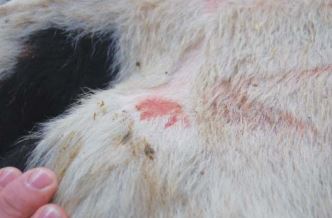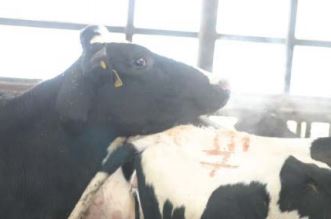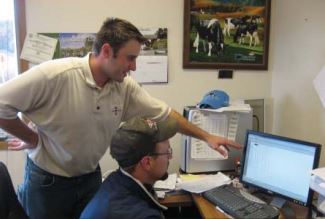
Detection of estrus (heat) is often cited as the most costly
component and undoubtedly, the major limiting factor to
the success of A.I. programs on many dairy farms. Traditionally,
the cow that stands still and allows others to mount her is in
“standing heat.” Standing is the primary sign of estrus and
determines the time of insemination since ovulation occurs 25 to
30 hours after the onset of standing activity. However, the average
period of “standing heat” is usually less than 10 hours and
consists of about one standing event per hour. Secondary signs of
heat may be an indication that the cow will soon display standing
estrus, is currently in estrus, or has already gone out of standing
heat. Since the degree of these advanced signs vary in length
and intensity, a combination or having multiple secondary signs
increases the reliability of the decision to breed. It can also help to
increase the amount of cows submitted to A.I. by allowing you to
breed those showing subtle heats or those that cannot be detected
otherwise. Dairy Herd Improvement summaries have reported that
approximately 50 percent of the possible heat periods are detected.
Observing for secondary signs of heat dictate that a series of
questions and observations of the cow are followed in an effort to
gather more information to make an accurate decision to breed
or not breed to confirm the decision to inseminate when standing
heat is not observed.
SECONDARY SIGNS OF HEAT
Secondary signs are caused by elevated levels of estrogen on
the day the animal is in heat. They are also most likely caused by
estrus-related activities and events. The primary sign of estrus
is a cow standing to be mounted by another cow(s) even though
she could have resisted the mounting activity. The reason why
secondary signs of estrus get this name is they can also be caused
by events other than estrus and are secondary to standing to be
mounted as a definitive sign. Therefore, a single secondary sign of
estrus should not be enough to make the decision to inseminate;
if a cow is not seen standing to be mounted and is suspected in
estrus, it will be necessary to have a combination of secondary
signs to confirm that the cow is really in estrus. Below are some of
the most commonly recognized secondary signs of estrus.
Rubbed marks: When a cow dismounts another, she slides down
her tail head and rump. Therefore she puts considerable pressure
on the pin bones and backbone, and this repeated abrasive action
pulls out hair and may produce red, bloody or swollen sores. Size,
appearance, and freshness of these marks along with the fact that
few other events can cause similar signs; make these rubbed marks
one of the most reliable secondary indicators of estrus. Additionally,
you may find that the flanks of the cow in question have dirt or
manure marks from the hooves of other cows riding them and are
another indication that riding events have recently happened.
Mucus: Many technicians would state that mucus is the most
preferred secondary sign of estrus. Experienced inseminators put
a profound credence on this sign when deciding to breed or not
to breed a cow, and sometimes they even massage the cervix and
anterior vagina to express a mucus discharge. Discharged mucus
dries quickly so finding dried mucus on the tail, flanks or legs is just
as good a secondary sign as seeing a string of clear viscous mucus
coming from the vulva.
Sweaty appearance: Some cows will develop a sweaty appearance
when in estrus. This “wet” appearance, even though it is easily
detected, is frequently overlooked and may be where the slang term
“hot” cow originated.
Swollen Vulva: Rapidly growing follicles produce high circulating
levels of the hormone estrogen that increase blood flow to the
reproductive tract. The vulva increases in size and takes on a
pinkish swollen appearance. Upon opening the labia an intense dark
pink to red and highly moistened vagina is present if the cow is in
estrus. In contrast, the vagina will appear dry and pale to white in
color when the cow is not in estrus.
Rubbed marks are one of the most reliable secondary indicators of estrus. 
Chin resting Chin resting is thought to be testing by herd mates
to determine if an individual is receptive to be mounted. This
testing is performed by first resting a chin on the back of the cow.
Considerable salivating and licking usually takes place during this
testing process so you should inspect toplines for saliva.
Bellowing and urination: There is a tendency for increased
urination. The cow will begin holding her ears erect, become restless
and nervous. Cows coming into heat will become more active
and will spend more time walking around rather than lying down
chewing their cud. Be aware that during movement, like to and
from the milking parlor, is an ideal time for a cow to mount another
and therefore a great time to detect mounting activity. Some cows
may appear to be standing when in fact they just couldn’t get away
because of crowding. Extra care should be taken to avoid false
indicators like this one.
Bloody discharge: A streak of blood in the mucus usually means
that cow had a high peak of estrogen one to three days prior. It
is therefore recommended to record that heat and date it as two
days ago. This only indicates that she has been in heat. It has no
relationship with timing ovulation or whether or not she conceived.
Grouping: Cows in heat tend to look for willing partners to get
involved in estrus-related activities. These sexually active groups
are a clear indication that at least one cow inside one of these
groups is in estrus.

Records: A good record keeping system is one of the most valuable
tools in any detection program, mostly because it will increase the
accuracy of your decisions. All heats must be recorded even if the
cow is not bred at that heat. The pivotal question is when the last
insemination occurred. Having an interval of 18 to 24 days makes
the decision to inseminate easy. Breedings that occur with an
estrus interval of four to 16 days usually result in less than desired
conception rates and should be avoided unless the secondary signs
strongly sway the decision to inseminate. Also knowing if the cow’s
previous breeding was a result of timed A.I. or from a standing event
may alter your decision. These off-cycle cows could be palpated
for the presence of thick, clear mucus as the final and definitive
secondary sign to confirm the decision to inseminate.
SUMMARY
Traditionally the cow that stands still and allows others to mount
is in “standing heat.” Standing is the primary sign of estrus and
determines the time of insemination since ovulation occurs 25 to 30
hours after the onset of standing activity. Secondary signs of estrus
may be an indication that the cow may soon display standing heat,
is standing now, or has already gone out of standing heat. Since
the degree of these advanced signs vary in length and intensity,
a combination or having multiple secondary signs increases the
reliability and the result of the decision to breed. Making the
decision to inseminate many times will require the use of secondary
signs of estrus. There is a fine line when using secondary signs to
make the decision to breed or not to breed that will only come with experience.
PDF IN ENGLISH